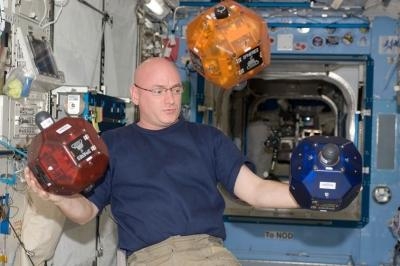Fri, Mar 21, 2014
Paves The Way For Future Deep Space Missions
In a breakthrough that will help make it possible for astronauts and robots to work together in deep space, researchers at the Lockheed Martin Advanced Technology Center (ATC), working with NASA astronauts aboard the International Space Station, have demonstrated coordinated control of robots in space by astronauts in space and operators on the ground. The breakthrough is the first-ever demonstration of such collaborative tele-operations. The maneuvers create new opportunities to extend the reach of human and robotic missions in Earth orbit and beyond.

Astronaut Karen Nyberg and ATC engineer Humberto Ormeno used an ATC-developed, 3-D user interface to command NASA's Synchronized Position Hold, Engage, Re-orient, Experimental Satellites (SPHERES) robots on the space station. Inside the space station, the robots (each about the size of a soccer ball) were commanded in "follow-the-leader" exercises and simulated approach-and-docking maneuvers, like those required for in-space assembly of large space structures and asteroid exploration. There is also flexibility within the system, meaning automated control of one or more robots can be combined with manual control of another.
Remote commanding of robots in space, or tele-operation, poses several unique challenges. Commands and telemetry can take one to three seconds to travel between space and the ground via satellite relays, forcing remote operators to predict the effects of their actions using old data. Delicate components designed for weightlessness can be damaged by accidental collisions or even exhaust gases produced by other satellites, so safe maneuvering is essential. The work on the space station is demonstrating how to deal with the time delays associated with signal transfer from the ground.
"The ATC has started to confront these challenges by performing multiple experiments with the SPHERES robots, through a no-cost Space Act Agreement with the International Space Station National Laboratory Office," said Dr. Nelson Pedreiro, ATC director of Science and Technology. "This technology exemplifies how breakthroughs can be achieved in a cost-effective and agile manner."
"Supervising a team of robots in microgravity requires intuitive and informative user interfaces so operators can maintain control over sensitive maneuvers without being overwhelmed by details," says Andrew Zimdars, who leads the ATC effort. "SPHERES enables us to work with the astronauts who will command future exploration missions and develop software technologies that meet their needs."
(SPHERES image provided by NASA)
More News
Terminal Radar Service Area Airspace surrounding designated airports wherein ATC provides radar vectoring, sequencing, and separation on a full-time basis for all IFR and participa>[...]
Aero Linx: Utah Back Country Pilots Association (UBCP) Through the sharing experiences, the UBCP has built upon a foundation of safe operating practices in some of the most challen>[...]
From 2010 (YouTube Edition): Imagine... Be The Change... Inspire FROM 2010: One of the more unusual phone calls I have ever received occurred a few years ago... from Anousheh Ansar>[...]
(Pilot) Felt A Shudder And Heard The Engine Sounding Differently, Followed By The Engine Chip Detector Light On April 14, 2025, about 1800 Pacific daylight time, a Bell 206B, N1667>[...]
Also: AMA Names Tyler Dobbs, More Falcon 9 Ops, Firefly Launch Unsuccessful, Autonomous F-16s The Air Force has begun ground testing a future uncrewed jet design in a milestone tow>[...]
 ANN's Daily Aero-Term (05.07.25): Terminal Radar Service Area
ANN's Daily Aero-Term (05.07.25): Terminal Radar Service Area ANN's Daily Aero-Linx (05.07.25)
ANN's Daily Aero-Linx (05.07.25) Classic Aero-TV: Anousheh Ansari -- The Woman Behind The Prize
Classic Aero-TV: Anousheh Ansari -- The Woman Behind The Prize NTSB Prelim: Bell 206B
NTSB Prelim: Bell 206B Airborne-NextGen 05.06.25: AF Uncrewed Fighters, Drones v Planes, Joby Crew Test
Airborne-NextGen 05.06.25: AF Uncrewed Fighters, Drones v Planes, Joby Crew Test



